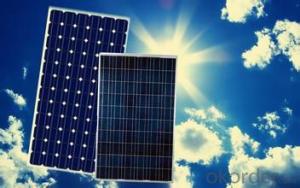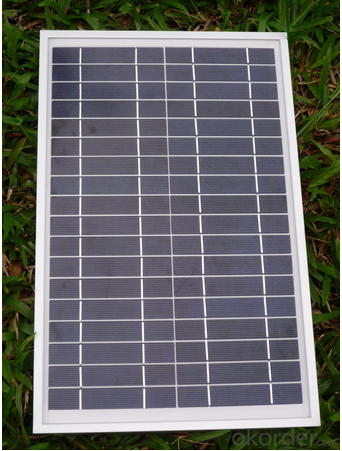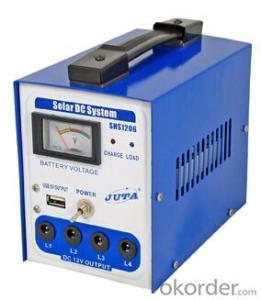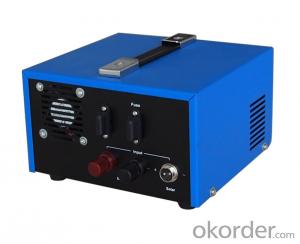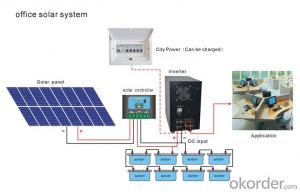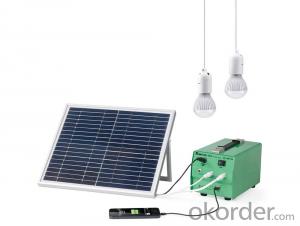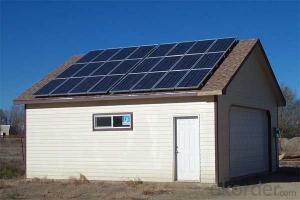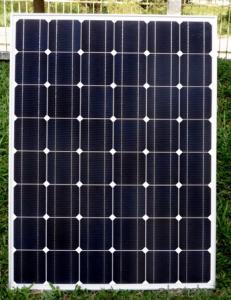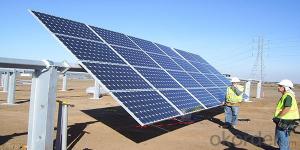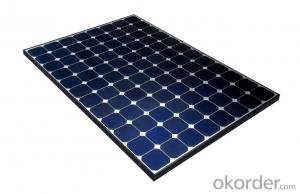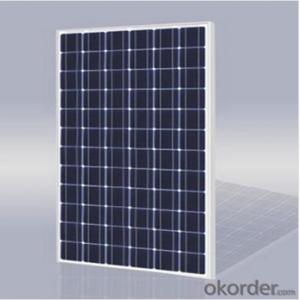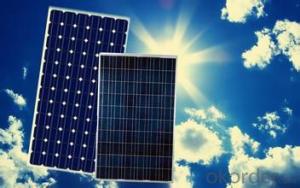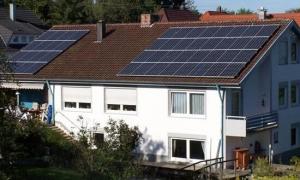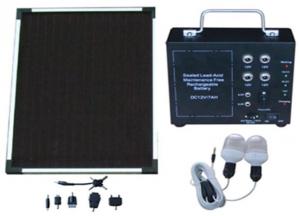Ecs Solar Energy Systems 66kw CNBM Monocrystalline Silicon Panel for Home Use
- Loading Port:
- Tianjin
- Payment Terms:
- TT OR LC
- Min Order Qty:
- 50 watt
- Supply Capability:
- 1000 watt/month
OKorder Service Pledge
OKorder Financial Service
You Might Also Like
Specification
66KW CNBM Monocrystalline Silicon Panel for Home Using
Production description
Solar energy is radiant light and heat from the Sun harnessed using a range of ever-evolving technologies such assolar heating, photovoltaics, solar thermal energy, solar architecture and artificial photosynthesis.
It is an important source of renewable energy and its technologies are broadly characterized as either passive solar oractive solar depending on the way they capture and distribute solar energy or convert it into solar power. Active solar techniques include the use of photovoltaic systems
Off-the-grid homes are autonomous; they do not rely on municipal water supply, sewer, natural gas, electrical power grid, or similar utility services. A true off-grid house is able to operate completely independently of all traditional public utility services. The idea has been recently popularized by certain celebrities including Ed Begley, Jr.[1] who stars in Living with Ed[2] television show on the Home & Garden Television (HGTV) network. Actress Daryl Hannahpromotes off-grid living and constructed her home in Colorado according to those principles, as does survival expert and Dual Survival co-star Cody Lundin,[3]who lives in a self-designed, passive solar earth house in the high-desert wilderness of Northern Arizona, collecting rainwater, composting waste, and paying nothing for utilities.[4][5]
The large magnitude of solar energy available makes it a highly appealing source of electricity. The United Nations Development Programme in its 2000 World Energy Assessment found that the annual potential of solar energy was 1,575–49,387 exajoules (EJ). This is several times larger than the total world energy consumption, which was 559.8 EJ in 2012.
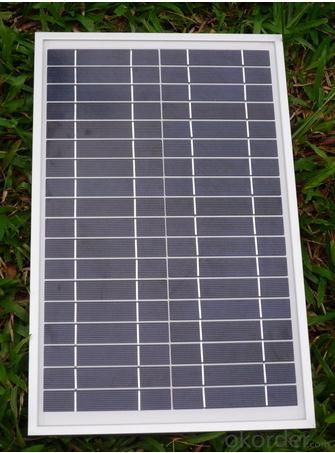
Feature
1.High conversion efficiencies resulting in superior power output performance.
2.Outstanding power output even in low light or high temperature conditions
3.Optimized design for ease of soldering and lamination
Physical characteristic
1. Rigorous quality control meets the highest international standards.
2. High-transmissivity low-iron tempered glass, strong aluminium frame.
3. Using UV-resistant silicon.
4. IS09001/14001/CE/TUV/UL
Packaging
26pcs in one carton 6pallets in 20foot container 14pallets in 40 foot container.
- Q: Are there any fire risks associated with solar energy systems?
- Yes, there are fire risks associated with solar energy systems, although they are relatively low. The most common fire risk is with faulty electrical components or improper installation, which can lead to short circuits or overheating. However, these risks can be minimized through proper installation, regular maintenance, and adherence to safety codes and regulations.
- Q: What is the impact of fire on solar panels?
- Solar panels can suffer significant and detrimental effects from fires. These fires can directly damage the panels, resulting in complete destruction or rendering them inoperable. The high temperatures generated by fires can cause delicate components, such as the photovoltaic cells and wiring, to melt or warp. This damage can render the panels incapable of producing electricity. Moreover, fires produce smoke and soot that can cover the surface of solar panels, obstructing sunlight and reducing their efficiency. This diminishes the amount of light they can absorb, resulting in a significant decrease in power output. In addition to physical damage, fires pose a safety risk to the surrounding area. Since solar panels are often installed on rooftops or in open areas, they are vulnerable to fire hazards. If a fire occurs near or on a solar panel, it increases the risk of spreading and causing further property damage. To minimize the impact of fires on solar panels, it is crucial to implement proper fire safety measures. This includes using fire-resistant materials for installation and ensuring adequate protection from potential fire sources. Regular maintenance and cleaning are also necessary to remove debris and soot, maximizing efficiency and reducing the risk of damage during a fire. Overall, fires can have severe consequences for solar panels, including physical damage, reduced efficiency, and safety risks. Taking necessary precautions and implementing fire safety measures are essential to protect solar panels and minimize potential losses.
- Q: Can solar energy systems be used in powering hotels or resorts?
- Yes, solar energy systems can be used to power hotels or resorts. Solar panels can be installed on the rooftops or open spaces of these buildings to harness sunlight and convert it into electricity. This renewable source of energy can provide a significant portion or even the entire power required for the hotel or resort, reducing reliance on traditional fossil fuel-based electricity and lowering operational costs. Additionally, solar energy systems can also be integrated with other energy-efficient technologies like energy storage systems and smart grids to ensure uninterrupted power supply and optimize energy usage.
- Q: How much space is required for installing a solar energy system?
- Several factors can influence the amount of space needed to install a solar energy system. These factors include the size of the system, the energy requirements of the property, and the available space. For residential installations, the space needed for solar panels typically ranges from 100 to 400 square feet per kilowatt (kW) of capacity. This estimate includes both the actual area occupied by the panels and the necessary spacing between them for optimal sunlight exposure. In larger-scale or commercial installations, the space required can be much larger. These installations often involve multiple arrays of panels and can require several acres or more. It's important to note that solar energy systems can be installed on various surfaces, such as rooftops, ground-mounted systems, or even integrated into building materials. Rooftop installations are common in residential settings, as they make use of available roof space to maximize energy generation. Ground-mounted systems are often used in commercial or rural areas where there is ample land. To accurately assess the space requirements for your installation, it is essential to consult with a professional solar installer. They can evaluate your specific energy needs, available space, and other site-specific factors. Local regulations and shading from nearby structures or trees can also impact the space needed for a solar energy system.
- Q: Can solar energy systems be used for powering off-grid educational institutions?
- Yes, solar energy systems can indeed be used for powering off-grid educational institutions. Solar panels can be installed on the rooftops of buildings to harness the sun's energy and convert it into electricity. This renewable energy source can then be used to power various electrical appliances, lighting, and other necessities within the educational institution. By utilizing solar power, off-grid educational institutions can reduce their dependence on traditional energy sources and contribute to a more sustainable and environmentally friendly way of generating electricity.
- Q: Can solar energy systems be used for powering mining operations?
- Yes, solar energy systems can be used for powering mining operations. Solar power can be harnessed through the installation of solar panels, which convert sunlight into electricity. This renewable energy source can provide a sustainable and cost-effective solution for powering mining operations, reducing reliance on fossil fuels and minimizing environmental impact. Additionally, solar energy can be integrated with energy storage systems to ensure a continuous power supply even during periods of low sunlight.
- Q: Can solar energy systems be installed in urban areas with limited space?
- Solar energy systems can indeed be installed in urban areas with limited space. Despite the fact that urban areas often have limited rooftop space for solar panel installation, there are several creative solutions that can be used to overcome this challenge. One option is to install solar panels on vertical surfaces like walls or building facades. This approach makes the most of the available space and doesn't require additional land. By utilizing vertical space, solar energy systems can still generate a significant amount of electricity even in densely populated urban areas. Another solution is to implement community solar projects. These projects involve installing solar panels in a centralized location within the urban area, such as a parking lot or vacant lot. The electricity generated by these panels can then be shared among multiple buildings or households, allowing those with limited rooftop space to still benefit from solar energy. Furthermore, advancements in technology have resulted in the development of more efficient and compact solar panels. These panels can generate the same amount of electricity as traditional panels with less surface area, making them more suitable for installation in limited urban spaces. In addition to these solutions, it's important to consider the potential of integrating solar energy systems into existing infrastructure. For instance, solar panels can be installed on top of bus stops, streetlights, or even on the sides of bridges and highways. This allows for the utilization of spaces that would otherwise go unused. In conclusion, although limited space can be a challenge, there are various ways to install solar energy systems in urban areas. With innovative approaches and technological advancements, solar power can be harnessed even in densely populated cities, contributing to a more sustainable and renewable energy future.
- Q: Can a solar energy system be installed on a ground mount?
- Indeed, it is possible to install a solar energy system on a ground mount. In reality, ground-mounted solar systems are highly popular and offer numerous advantages compared to roof-mounted systems. Ground-mounted systems typically have a larger size and can accommodate a greater number of solar panels, resulting in increased energy production. They can also be positioned at the ideal angle and orientation to maximize sunlight exposure, which may not always be achievable on a roof. Furthermore, ground-mounted systems are more easily accessible for maintenance and cleaning since they are not situated on the roof. Therefore, if there is ample space available on your property, opting for a ground-mounted solar energy system can be an exceptional choice for generating clean and renewable energy.
- Q: Are there any risks of electromagnetic radiation with solar energy systems?
- Solar energy systems have potential risks related to electromagnetic radiation. These systems utilize photovoltaic panels to convert sunlight into electricity. The panels produce direct current (DC) electricity, which is then changed to alternating current (AC) electricity for use in homes and businesses. One potential source of electromagnetic radiation is the inverter, responsible for converting DC electricity to AC electricity. In some cases, these inverters may generate electromagnetic fields (EMFs) that emit low-frequency radiation. Although these EMFs are generally considered low and within acceptable limits, ongoing research aims to better understand any potential health effects from long-term exposure to these fields. Another risk involves high-frequency electromagnetic radiation from radio frequency (RF) communication devices, like wireless monitoring systems or communication modules used in solar energy systems. These devices wirelessly transmit and receive signals, causing concern about potential health effects from long-term RF radiation exposure. However, these devices typically have low power levels and are designed to comply with safety standards and regulations. It's important to note that the risks associated with electromagnetic radiation from solar energy systems are generally considered low compared to other everyday sources, such as cell phones, Wi-Fi routers, or power lines. Nonetheless, it is always advisable to follow safety guidelines provided by manufacturers and industry standards to minimize potential risks.
- Q: How do solar energy systems impact the overall sustainability of a home?
- Solar energy systems have a significant impact on the overall sustainability of a home. Firstly, they greatly reduce dependence on fossil fuels, which are finite and contribute to climate change. By harnessing the power of the sun, solar energy systems generate clean, renewable electricity that doesn't produce harmful emissions or pollutants. This not only helps to mitigate climate change but also improves air quality in the surrounding environment. Furthermore, solar energy systems provide homeowners with energy independence and resilience. By generating their own electricity, homeowners can reduce their reliance on the grid and avoid the volatility of energy prices. This can lead to long-term cost savings and greater financial stability. Additionally, during power outages or natural disasters, solar energy systems with battery storage can provide a reliable source of electricity, ensuring essential appliances and systems keep running. Solar energy systems also increase the energy efficiency of a home. By supplementing or replacing traditional energy sources, these systems reduce the overall energy consumption of a household. This, in turn, lowers utility bills and conserves resources. Moreover, the installation of solar panels can increase the value of a home. As renewable energy becomes more popular and desirable, potential homebuyers are increasingly willing to pay a premium for properties with solar energy systems. This not only benefits homeowners who are looking to sell their homes but also contributes to the overall growth and adoption of sustainable energy solutions. Lastly, solar energy systems promote a sense of environmental stewardship and sustainability. By utilizing renewable energy, homeowners can actively contribute to reducing their carbon footprint and preserving the planet for future generations. This commitment to sustainability extends beyond the household, inspiring others to embrace clean energy and work towards a greener future. In conclusion, solar energy systems have a positive and far-reaching impact on the overall sustainability of a home. They reduce dependence on fossil fuels, increase energy efficiency, provide energy independence and resilience, boost property value, and promote environmental stewardship. By harnessing the power of the sun, solar energy systems pave the way for a more sustainable and resilient future.
Send your message to us
Ecs Solar Energy Systems 66kw CNBM Monocrystalline Silicon Panel for Home Use
- Loading Port:
- Tianjin
- Payment Terms:
- TT OR LC
- Min Order Qty:
- 50 watt
- Supply Capability:
- 1000 watt/month
OKorder Service Pledge
OKorder Financial Service
Similar products
Hot products
Hot Searches
Related keywords
